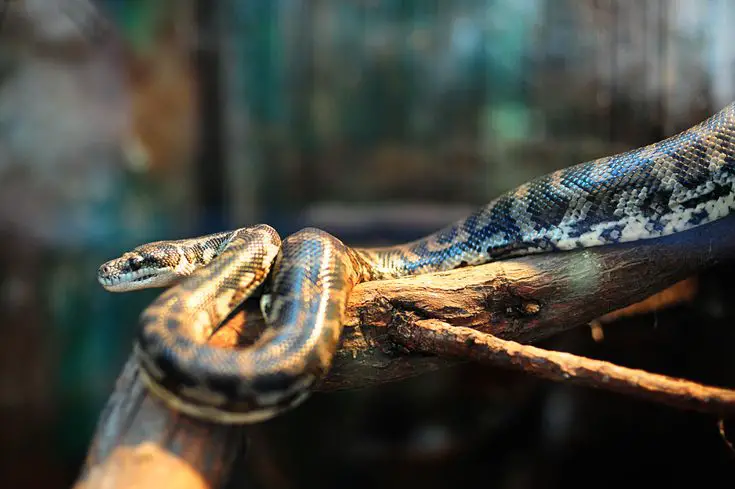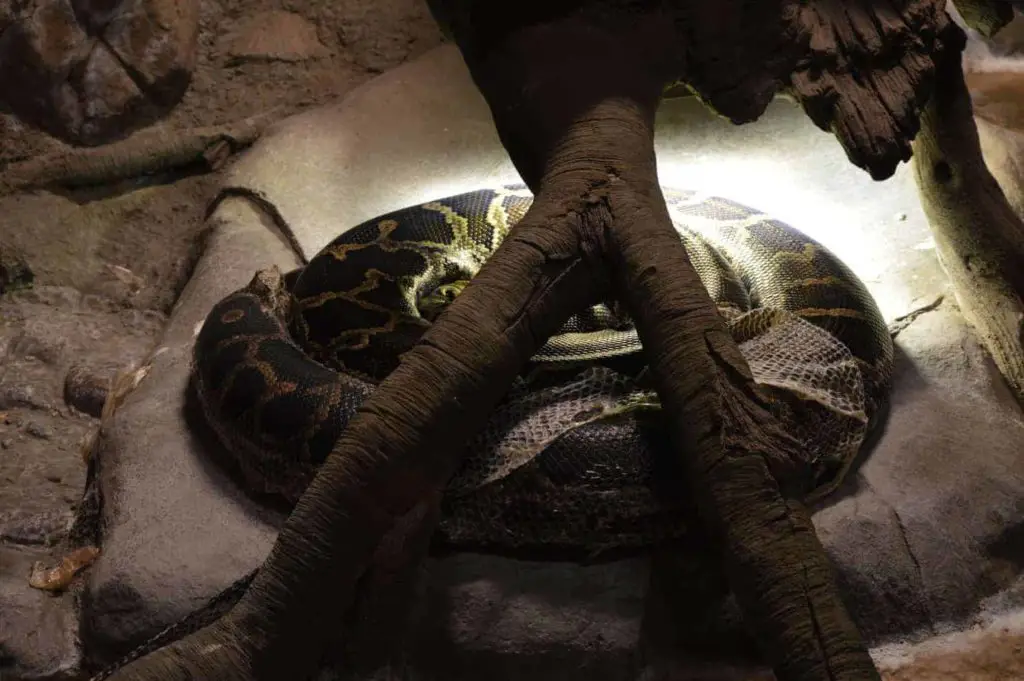Snakes are cold-blooded animals that can’t generate their own body heat. They need to be kept warm in order to survive for an extended period of time, but since they can’t produce their own body heat, this task falls to the owner.
This means that it’s basically your responsibility to keep a snake warm and since you can’t leave your snake in the sun, you will need to do this through a heat source like a heat lamp.
But what happens if it goes out while you’re away? What if this happens during the winter months? Will your snake survive the cold until you get back and fix it?
To put the question in the simplest form: How long can snakes go without heat? Most Pet Snakes can go without heat for about 6 hours in 70-80° F (21.1-26°C) and the duration shortens as the temperature drops, but the exact duration and temperature will depend on the snake’s species, age, and health. Snake’s bodies will start to shut down if left without heat for too long
As a general rule of thumb, your snake should not be left without heat for more than a few hours, and you should not only have a way of providing constant heat and light to your snake but also need to have a backup for what to do when the first option fails, say the lamp goes out for one reason or another.
In this article, I’m going to discuss exactly why snakes need heat, how much heat do they need, the best ways to provide it, and what happens if the snake gets too cold. I am, of course, going to be using the most popular pet snakes as examples to make this as helpful as possible, so stick around as I answer all the questions you are thinking of (and the ones you should be thinking of but don’t know you should be).
Contents
How Long Can a Snake Go Without Heat?

Snakes are reptiles, which means they are all cold-blooded (ectotherms). This implies that they are not animals that create their own body heat.
A snake’s body temperature is regulated by its environment. If the snake cannot find a warm place to live, it will eventually die.
In the wild, snakes can go without heat for up to three months during winter.
However, in captivity, snakes may only be able to go without heat for a few days or weeks. Without proper care, a captive snake can die from the cold.
The average body temperature of a snake is about 86 degrees Fahrenheit. However, this may vary depending on the species of snake. Some snakes, such as the king cobra, can have a body temperature up to 106 degrees Fahrenheit.
Snakes rely on their surroundings to regulate their body temperature. When it is cold, they will find a place to hide that is warm.
If it is hot, they will move to a shady spot. If the snake cannot find a warm or cool place to live, its body temperature will start to decrease and it will eventually die.
This is why some people find snakes hibernating in their houses during the winter months, as it was the best place the snake can find to spend the cold winter months.
Why do snakes need heat?

Since snakes are reptiles, they are cold-blooded animals, which means their body temperature is regulated by the environment.
They need heat for their bodies to function just like mammals do, but unlike mammals, they can’t generate their own body heat. However, they also need to cool off.
Why do Snakes need to cool down
While snakes require heating for their body functions to work, they also need to find a way to get rid of excess heat. Snakes will often find a cool spot, like inside caves, under rocks, or below the sands where the cooler ground can absorb their body’s excess heat.
How do you know your snake is too cold?
There are some behaviors and changes that can tell you that your snake is indeed too cold and need some heat:
- The snake will try to seek out a warmer area of their enclosure.
- If they can’t find a warm spot in their enclosure, your snake will try to escape.
- If they can’t escape, you will notice them trying to huddle to keep their body temperature as warm as possible.
- As their bodies get colder, they will not be able to digest the foods they have in their stomachs, so to get rid of the rotten and spoiled food, they will try to vomit or regurgitate depending on how digested the food already is.
- The snake will then stop eating and will not be interested in any prey or food you offer to them
- The snake will reduce its movement to a minimum or will stop moving at all.
- Because the snake can’t eat, they are going to be more vulnerable to diseases and sickness
- If your snake already has a health condition, the drop in body temperature will make them worse and it can worsen quickly
- If the snake still remains too cold, hypothermia will start to kick in and they may eventually die from it.
How fast do snakes get too cold?
Snakes can get too cold in a few hours and without a heat source, their body will start to react adversely to the cold very quickly.
How fast do snakes get too cold will depend on many factors, including the snake species, age, health, and the ambient temperature.
Factors like younger age, worse health, and lower ambient temperature can all shorten the duration the snake can survive without a heat source.
What happens if a snake gets too cold?
If a snake gets too cold, it will try to find ways to warm up or how long can snakes go without heat.
However, there are some things that may happen if the snake doesn’t get back into their optimal body temperature:
Their bodily functions like digestion and organ function slow down as they cool further down.
The snake may experience anemia because their red blood cells are becoming more fragile as they get colder.
They will not be very active and spend most of the time in a dark place to conserve energy, which can also put them at risk for contracting parasites or diseases another animal has.
Their immune system is weakened by how long can snakes go without heat, which makes the snake susceptible to any sickness or disease.
If the snake’s temperature drops below a certain threshold, they may enter into a state of hypothermia and eventually die from it.
As you can see, how long can snakes go without heat is very important for their health and well-being.
Make sure to provide a heat source in your snake’s enclosure if they are kept as pets and monitor their body temperature regularly to make sure they are healthy!
The Best Tank Temperatures for popular pet snakes

Below is a table with some of the requirements of the most popular snake species.
| Species | Basking Spot Temperature | Ambient Temperature |
|---|---|---|
| Corn Snake | 85 °F 29.4 °C | 75 °F 23 °C |
| Ball Python | 90 °F 32.3 °C | 80 degrees |
| Boa Constrictor: | 90 °F 32.3 °C | 75 °F 23 °C |
| Hognose Snake: | 88 °F 31.11 °C | 78 °F 25.5 °C |
| California Kingsnake: | 85 °F 29.4 °C | 75 °F 23 °C |
| Rosy Boa: | 85 °F 29.4 °C | 75 °F 23 °C |
| Gopher Snake: | 85 °F 29.4 °C | 75 °F 23 °C |
Should you turn off your heat mat or lamp at night?
You should no turn off your snake cage’s heat source at night. Just like your snake can’t generate heat during the day, it can’t do that during the night. In fact, it’s colder at night so it’s even more important to keep the lamps on when the sun goes down.
There are heat lamps that have lights that can be switched off, this way they can still provide snakes with heat during the night but without the distraction of the bright lights.
What to do if the heat goes out?
There are a few things you can do to keep your snake warm enough that he’ll survive if an emergency, such as a power outage or the heater failing suddenly.
If the power goes out, one thing you can do is purchase a small generator that you may connect to your snake tank. It should be able to keep the heater and basking spot running until the electricity resumes.
Generators can be pricey, so if you don’t have one and your snake’s heater dies, there are a few things you can do to keep it warm until you get another.
Another option is to fill a basin or bowl with boiling water and place it in the snake’s tank. He can approach the vessel holding the water and use it to warm up his body.
Say you don’t have hot water or that the heat source has been changed and you’re waiting for the tank to warm up.
Another choice is to keep your snake close to your body while the tank warms up. He may absorb some of your body heat in order to stay warm. Some pet snakes will instinctively lay straight next to you for this reason when you let them out of the tank to handle them.
Conclusion
As you can see, maintaining the right heat and body temperature for your snake is a crucial part of owning a pet snake, so you should be always ready and informed about what you should do and what to do in case of an emergency.
Losing heat in the house may not be so critical for your dog or cat, but it is for your snake because it can’t generate its own body heat, which is something you should always keep in the back of your head as a snake owner.
This is so important because snakes can go without food or water for weeks at a time, but they can’t survive without heat even for a few hours.
You can also learn how long can snakes survive without food here, and how long can snakes survive without water here.
Related Questions
How Long can a Ball Python go without heat?
In 75°F temperatures, Ball pythons can survive for 6 hours before the body begins to shut down and they begin to suffer. Anything colder than 75°F reduces the length of time your snake can go without heat, and prolonged temperatures below 65°F for even a few hours may be deadly for snakes.
Can Snakes survive without a heat lamp?
Snakes cannot survive without a heat source, so as for captive snakes, they will not be able to survive even a few hours without a heat lamp if that’s their only source of heat.
Do Snakes need light or just heat?
Snakes need the heat and not the light with the exception of very few species. Snakes can survive in the dark completely fine if they have heat.
Helpful Resources
Thermal Behavior, Heat Exchange, and Metabolism in the Desert Snake Spalerosophis cliffordi
If you like this article, please share it!

